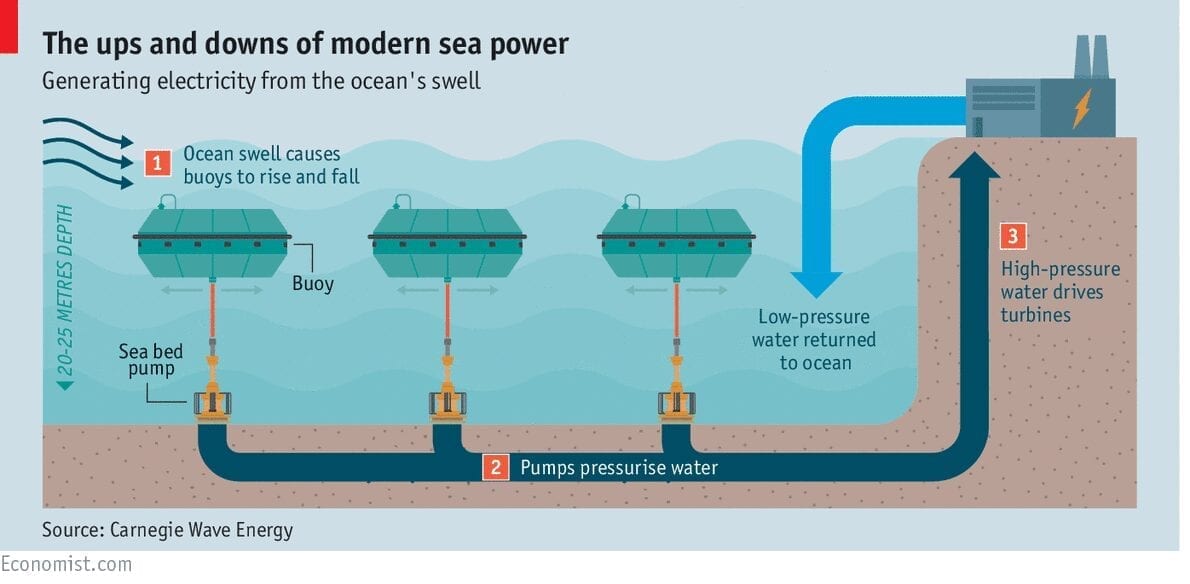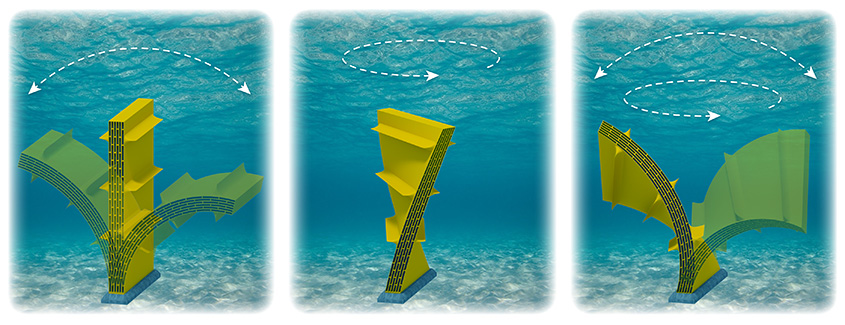
NO LAND stands between Antarctica and Australia’s west coast—just a vast ocean, rippled and rocked by the Roaring Forties.
For centuries these westerlies, which blow between latitudes 40° S and 50° S, powered ships sailing from Europe to Asia. These days, they are also creating waves in the world of renewable energy. At the end of February, a demonstration project designed to use the ocean swell they produce went live. As a result Australia’s largest naval base now gets part of both its electricity and its fresh water courtesy of the ’Forties.
Carnegie Wave Energy, in Perth, has been working since 1999 on what it calls CETO technology. Ceto was the ancient Greek goddess of sea monsters, and Carnegie’s particular monsters are buoys that resemble giant macaroons. They float a metre or two below the ocean’s surface, bobbing up and down in the swell and generating electricity as they do so. The current version, CETO 5, has a capacity of 240kW per buoy. Three of the beasts are now tethered to the sea bed 3km from HMAS Stirling, on Garden Island. They also help to run a desalination plant on the base, for fresh water is a valuable commodity in Western Australia’s arid climate.
The buoys themselves are 11 metres across, made of steel and filled with a mixture of seawater and foam to give them a density slightly below that of water, so that they float. Being submarine means that, unlike previous attempts to extract power from waves, they are not subject to storms and the constant battering that life at the interface between sea and air brings. As Michael Ottaviano, Carnegie’s boss, observes, savvy swimmers in Australia know to dive under—not through—an approaching wave, to avoid getting smashed. The same applies to buoys.
Even below the surface, though, the swell is enough to generate power. Each buoy’s rising and falling drives, as the diagram shows, a pump attached to the seabed at the bottom of that buoy’s tether. This pump pushes water through a pipe to a power station on Garden Island. There, the water’s pressure spins turbines that turn a generator. This arrangement produces about 5% of the base’s electricity.
The pressure can be put to a second use, too—to run a process called reverse osmosis, which removes salt from water. Osmosis happens when a solution of salt and a body of pure water are kept apart by a membrane permeable to water molecules, but not to the ions of which salt is composed. The resulting “osmotic” pressure on the water propels it into the brine through the membrane. Apply sufficient physical pressure to the brine, though, to overcome the osmotic pressure, and H2O will go the other way—which is a neat trick if you want to desalinate seawater.
Creating the necessary pressure requires a lot of energy. Reverse-osmosis desalination plants thus tend to guzzle diesel or electricity. But CETO 5 dispenses with all that. It delivers water at a high enough pressure for reverse osmosis to happen automatically. As a result, about a third of Stirling’s freshwater comes from desalination driven by wave power.
Carnegie aspires to bigger and better buoys it hopes will generate a megawatt each when launched in 2017. These versions, CETO 6, will be 20 metres across and will produce electricity inside themselves instead of at an onshore power plant. That means no pipe is needed; a submarine power cable will do instead.
Read more: A new project off the coast of Australia may make wave power a reality
The Latest on: Wave power
[google_news title=”” keyword=”Wave power” num_posts=”10″ blurb_length=”0″ show_thumb=”left”]
via Google News
The Latest on: Wave power
- Mexico hit by hours of rolling blackouts due to high temperatures and low power generationon May 8, 2024 at 11:37 am
Mexico has been hit by hours of rolling blackouts late Tuesday due to high temperatures and temporary drops in electrical power generation.
- Russia Launches New Wave of Attacks on Ukrainian Energyon May 8, 2024 at 9:30 am
Russia advanced into eastern Ukraine, taking two villages in two regions, Moscow said on Wednesday, in the aftermath of over 70 drone and missile attacks that targeted Ukrainian energy infrastructure ...
- Russia ramps up attacks on Ukraine’s power plantson May 8, 2024 at 9:15 am
People in several regions of Ukraine have been experiencing power blackouts after the latest wave of Russian attacks on the country's energy infrastructure. President Volodymyr Zelensky said there had ...
- Russia launches 'massive' wave of attacks on Ukraine's energy facilitieson May 8, 2024 at 2:18 am
In March, it launched a new wave of attacks, one of which completely destroyed the Trypilska power plant near Kyiv, one of the country's biggest. Russian President Vladimir Putin has framed the ...
- Unveiling the Power of Wave Springson May 8, 2024 at 1:06 am
In the realm of mechanical components, a wave spring is a distinctive type of compression spring characterized by its unique waveform-like structure. Whether your application demands axial space ...
- Rolling Blackouts Hit Several Cities as Heat Wave Scorches Mexicoon May 8, 2024 at 12:02 am
Local officials confirmed several blackouts in the state of Mexico, including in San Mateo Atenco and Metepec, near Mexico City. And during a blackout in the city of Nuevo Laredo, near the Texas ...
- Researchers make promising breakthrough in wave energy technology: 'New insight for the design and large-scale application'on May 7, 2024 at 3:15 am
This is an attractive idea for clean energy companies, as it does not face the same intermittency issues as wind and solar. Researchers make promising breakthrough in wave energy technology: 'New ...
- Second Chance At Life Powers Woman To Develop Award-Winning Wave Energy Technologyon April 30, 2024 at 4:30 am
I went for wave energy because I saw a field that has huge demand, huge potential for positive impact on the world, & that nobody's succeeding in, Braverman said.
- WAVE and HE are among utility moverson April 26, 2024 at 11:11 am
XLU: The Near-Term Outlook For The Utility Sector Is Not Promising (Rating Downgrade) Utilities Are Breaking Out: 4 Reasons To Buy XLU; XLU: A Poorly Positione ...
- Why Eco Wave Power Global Stock Is Up Over 150%on April 8, 2024 at 7:19 am
Eco Wave Power Global AB (publ) ADR WAVE shares are trading higher by 170% to $3.62 during Monday’s session after the company announced that it was selected by an international energy company to ...
via Bing News











